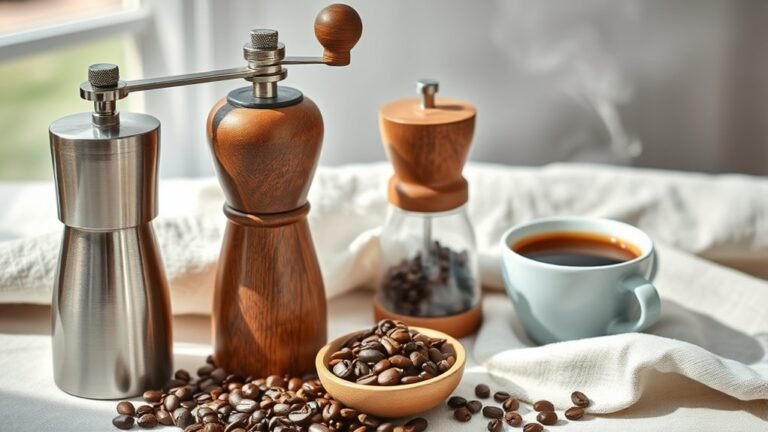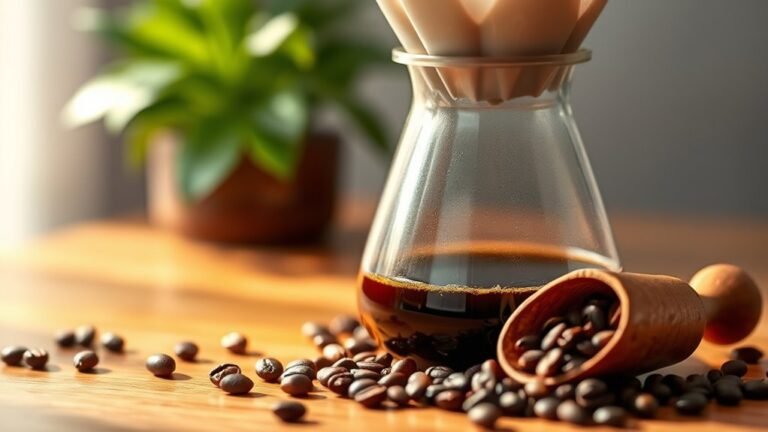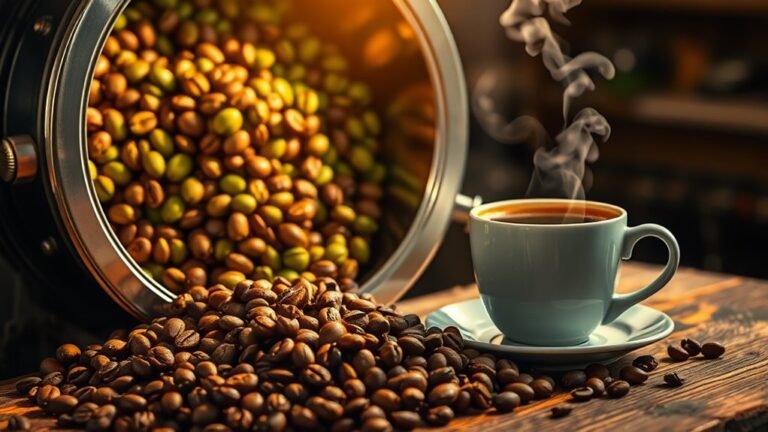The Best Coffee Beans for Your Brewing Method
To get the best flavor, match your coffee beans to your brewing method’s extraction and grind needs. Use coarsely ground, medium to dark roast beans for French press to avoid sediment and over-extraction. Espresso requires finely ground, medium to dark roasts, often blends, for balanced crema and complex flavors. Pour-over works best with light to medium roasted, high-altitude Arabicas for bright clarity. Drip coffee suits freshly roasted medium grinds. Cold brew favors fresh, medium-dark beans with low acidity for smoothness. Explore further for beans tailored to AeroPress and Moka pot too.
Selecting Beans for French Press Brewing

When selecting beans for French press brewing, you’ll want to focus on coarsely ground coffee with a robust flavor profile that can stand up to the full immersion method. The coarse grind is essential because it prevents over-extraction and reduces sediment in your cup, ensuring clarity without sacrificing depth. Since the brewing time typically spans four minutes, choose beans that can maintain balanced acidity and body throughout this extended contact with water. Medium to dark roasts often complement the French press well, as their oils contribute to a fuller mouthfeel and richer aroma. By prioritizing beans with bold yet nuanced flavors, you’ll maximize the freedom to craft a cup that’s both complex and smooth, fully exploiting the French press’s unique extraction dynamics.
Ideal Coffee Beans for Espresso Machines
Although espresso machines demand finely ground coffee for ideal extraction, the choice of beans greatly influences the shot’s flavor, crema, and body. You’ll want to select espresso bean varieties that balance acidity, sweetness, and bitterness to suit your taste. Arabica beans often offer nuanced espresso flavor profiles with bright, fruity notes, while Robusta beans contribute higher crema and a bolder, earthier character due to their elevated caffeine content. Blends combining these varieties can deliver complexity and a rich mouthfeel. Additionally, beans with a medium to dark roast enhance caramelization and reduce acidity, optimizing extraction pressure and yield. To release freedom in your espresso experience, experiment with single-origin beans versus blends, and adjust grind size and dose accordingly to highlight the unique flavor attributes each espresso bean variety brings to your machine.
Best Beans to Use With Pour-Over Coffee
Pour-over coffee demands beans that emphasize clarity, brightness, and complexity to fully express the brewing method’s precise extraction capabilities. When selecting beans, you want those grown at high altitudes, typically single-origin Arabicas, because their denser structure enhances nuanced flavor extraction. Light to medium roasts are ideal, as they preserve the bean’s inherent acidity and floral or fruity notes, which pour-over brewing accentuates through controlled water flow and temperature. Avoid overly dark roasts since pour-over’s gentle brewing techniques highlight subtle aromas lost in heavier profiles. To maximize your freedom in flavor exploration, try beans with distinct terroir characteristics—Ethiopian or Kenyan varieties often yield vibrant, clean cups. This approach leverages pour-over’s precision, revealing a transparent and dynamic coffee experience tailored to your palate.
Choosing Coffee Beans for Drip Coffee Makers

Since drip coffee makers rely on consistent water flow and temperature control, selecting the right beans is essential to achieving balanced extraction and flavor clarity. You’ll want beans that prioritize freshness factors—opt for those roasted within the last two weeks to preserve volatile aromatics and nuanced flavor compounds. Medium roast profiles typically excel here, offering a harmonious balance without overwhelming bitterness or underdeveloped acidity. Grind size plays a critical role; using a medium grind guarantees peak extraction speed, preventing over-extraction or under-extraction that disrupts flavor clarity. Avoid overly fine grinds that clog filters or too coarse grinds that produce weak brews. By controlling freshness factors and matching grind size precisely to your drip brewer’s specifications, you release the freedom to enjoy a consistently vibrant, clean cup every time.
Recommended Beans for Cold Brew Coffee
Moving from drip coffee makers to cold brew, you’ll find that the bean characteristics and roast levels you choose greatly influence the smoothness and flavor depth of your final brew. To maximize cold brew benefits, prioritize bean freshness and opt for beans that yield a balanced, mellow profile. Here’s what to look for:
- Medium to dark roasts: enhance chocolatey, nutty notes without excessive acidity.
- Single-origin beans: provide distinct flavor clarity enhancing your brew’s complexity.
- Beans with a low oil content: prevent overly bitter or harsh extraction.
- Freshly roasted, ground just before brewing: guarantees optimal extraction and preserves subtle aromatic compounds.
Beans That Shine in AeroPress Brewing
When brewing with an AeroPress, you’ll want beans that balance brightness and body to highlight the device’s clarity and complexity. Medium to medium-dark roasts often excel, as they preserve nuanced acidity while delivering rich, rounded flavors. Selecting beans with distinct fruity or floral notes can elevate your AeroPress experience by enhancing its clean, concentrated extraction.
Flavor Profiles for AeroPress
Choosing the right coffee beans for AeroPress brewing can drastically elevate your cup’s complexity and clarity. Because AeroPress techniques allow for precise control over pressure and immersion time, your coffee grind size and bean selection become critical to revealing nuanced flavor profiles. Beans that excel here often feature:
- Bright acidity with citrus or berry notes, enhancing AeroPress’s clarity
- Medium body to balance extraction without overwhelming bitterness
- Floral or tea-like nuances that AeroPress’s gentle pressure preserves
- Sweet, caramelized undertones that develop with fine-tuned coffee grind adjustments
These profiles thrive because AeroPress brewing extracts clean, vibrant flavors while minimizing bitterness. When you pair these characteristics with your preferred grind and technique, you gain freedom to craft a cup tailored to your taste—whether you seek a lively morning boost or a smooth afternoon sip.
Roast Levels Ideal
The flavor attributes that AeroPress brewing highlights are closely tied to the roast level of your beans, which directly influences acidity, body, and aromatic complexity. If you prefer a bright, vibrant cup with pronounced fruity and floral notes, a light roast is ideal—it preserves origin characteristics and offers higher acidity that AeroPress accentuates. Conversely, if you lean towards a fuller-bodied, richer profile with chocolatey or smoky undertones, a dark roast suits AeroPress well, as its shorter extraction time captures the roast’s bold, caramelized flavors without bitterness. Ultimately, AeroPress’s versatility empowers you to experiment between light and dark roasts, adjusting grind size and steep time to reveal your preferred balance of clarity, intensity, and mouthfeel. This freedom lets you tailor each brew precisely to your taste.
Specialty Coffee Beans for Moka Pot Brewing
Although moka pots operate under lower pressure than espresso machines, selecting specialty coffee beans with a medium to dark roast profile enhances extraction by balancing acidity and bitterness. When choosing beans for moka pot brewing, focus on those that complement moka pot techniques and the specific bean grind needed for ideal flow. You’ll want beans that:
- Retain rich oils for a full-bodied cup without overwhelming bitterness
- Exhibit flavor notes that hold up to the intense heat and pressure
- Are roasted to a level that prevents under-extraction but avoids burnt flavors
- Have a grind size slightly coarser than espresso, ensuring steady water flow and balanced extraction
Frequently Asked Questions
How Should I Store Coffee Beans to Maintain Freshness?
To keep your coffee beans fresh, store them in airtight containers to prevent exposure to oxygen, which speeds up staling. Choose containers made of opaque materials to block light, and keep them in a cool, dark place with ideal temperatures between 50-70°F (10-21°C). Avoid refrigeration or freezing, as moisture can damage beans. Proper storage preserves flavor and aroma, giving you the freedom to enjoy fresh coffee whenever you want without compromising quality.
What Is the Difference Between Single-Origin and Blended Coffee Beans?
Imagine tasting the pure essence of one place versus a harmonious symphony of many. Single-origin beans offer distinct, traceable flavors, highlighting terroir’s influence—single origin benefits include clarity and unique character. Blended coffee beans, however, combine varied beans to craft balanced, consistent flavor profiles, smoothing out extremes. You’ll appreciate how single origins free your palate for exploration, while blends provide reliable, complex experiences, empowering your coffee choices with precision and freedom.
Are Organic Coffee Beans Worth the Extra Cost?
You might wonder if organic coffee beans are worth the extra cost. Organic certification guarantees the beans are grown without synthetic pesticides or fertilizers, reducing your exposure to harmful chemicals. This can lead to notable health benefits, including fewer toxins in your cup. Plus, organic farming often supports sustainable practices, giving you more freedom to enjoy your coffee with an environmentally responsible conscience. Ultimately, it’s a choice balancing quality, health, and values.
How Does Roast Level Affect Caffeine Content?
Imagine caffeine as a hidden treasure within coffee beans, revealed differently by each roast profile. Darker roasts, roasted longer, lose some caffeine through heat but allow easier caffeine extraction due to their porous structure. Lighter roasts retain slightly more caffeine, yet their denser beans mean extraction can be slower. So, your brew’s caffeine kick depends not just on the roast level but how efficiently your method pulls out that energetic essence.
Can Stale Beans Be Revived for Brewing?
You can’t truly revive stale beans, as their flavor profiles degrade irreversibly due to oxidation and moisture loss. While techniques like rehydrating beans slightly or adjusting grind size might mask some flatness, the chemical changes causing staleness—like loss of volatile aromatics—are permanent. To enjoy vibrant flavors and full-bodied coffee, it’s better to use fresh beans stored properly, preserving oils and compounds essential for your ideal brew.






